spark MAZDA MODEL CX-5 2020 Owners Manual (in English)
[x] Cancel search | Manufacturer: MAZDA, Model Year: 2020, Model line: MODEL CX-5, Model: MAZDA MODEL CX-5 2020Pages: 714
Page 118 of 714

Fuel and Engine Exhaust Precautions
▼Fuel Requirements (SKYACTIV-G 2.0,
S K YA C T I V- G 2 . 5 , S K YA C T I V- G 2 . 5 T )
Vehicles with catalytic converters or oxygen sensors must use ONLY UNLEADED FUEL,
which will reduce exhaust emissions and keep spark plug fouling to a minimum.
To achieve maximum engine performance, use the specified fuel.
Fuel Octane Rating*1 (Anti-knock index)
Regular unleaded fuel 87 [(R+M)/2 method] or above (91 RON or above)
*1 U.S. federal law requires that octane ratings be posted on gas station pumps.
Fuel with a rating lower than 87 octane (91 RON) will negatively affect the emission control
system performance and could also cause en gine knocking and serious engine damage.
CAUTION
USE ONLY UNLEADED FUEL.
Leaded fuel is harmful to the catalytic co nverter and oxygen sensors and will lead to
deterioration of the emission control system and or failures.
This vehicle can only use oxygenated fuels containing no more than 10 % ethanol by
volume. Damage to the vehicle may occur when ethanol exceeds this recommendation, or
if the gasoline contains any methanol. Stop using gasohol of any kind if your vehicle engine
is performing poorly.
Never add fuel system additives other than a Mazda genuine product, otherwise the
emission control system could be damaged. Consult an Authorized Mazda Dealer for
details.
Gasoline blended with oxygenates such as alcohol or ether compounds are generally
referred to as oxygenated fuels. The common gasoline blend that can be used with your
vehicle is ethanol blended at no more than 10 %. Gasoline containing alcohol, such as
ethanol or methanol, may be marketed under the name "Gasohol".
Vehicle damage and drivability problems resu lting from the use of the following may not be
covered by the warranty.
Gasohol containing more than 10 % ethanol.
Gasoline or gasohol containing methanol.
Leaded fuel or leaded gasohol.
▼ Fuel Requirements (SKYACTIV-D 2.2)
The vehicle will operate efficiently on diesel fuel with specification Ultra-Low Sulfur Diesel
(ULSD, 15 ppm sulfur or less) fuel that meets the ASTM D975 standard or the equivalent.
Before Driving
Fuel and Emission
3-28
CX-5_8HX6-EA-19I_Edition2_old
2019-9-19 9:26:07
Page 124 of 714

Fuel-Filler Lid and Cap
WA R N I N G
When removing the fuel-filler cap, loosen
the cap slightly and wait for any hissing to
stop, then remove it:
Fuel spray is dangerous. Fuel can burn skin
and eyes and cause illness if ingested. Fuel
spray is released when there is pressure in
the fuel tank and the fuel-filler cap is
removed too quickly.
Before refueling, stop the engine, and
always keep sparks and flames away from
the filler neck:
Fuel vapor is dangerous. It could be ignited
by sparks or flames causing serious burns
and injuries.
Additionally, use of the incorrect fuel-filler
cap or not using a fuel-filler cap may result
in a fuel leak, which could result in serious
burns or death in an accident.
Do not continue refueling after the fuel
pump nozzle shuts off automatically:
Continuing to add fuel after the fuel pump
nozzle has shut off automatically is
dangerous because overfilling the fuel tank
may cause fuel overflow or leakage. Fuel
overflow and leakage could damage the
vehicle and if the fuel ignites it could cause
a fire and explosion resulting in serious
injury or death.
CAUTION
Always use only a ge nuine Mazda fuel-filler
cap or an approved equivalent, available
at an Authorized Mazda Dealer. The wrong
cap can result in a serious malfunction of
the fuel and emission control systems.
(SKYACTIV-G 2.0, SKYACTIV-G 2.5, and
SKYACTIV-G 2.5T for U.S.A. and Canada)
It may also cause the check engine light in
the instrument cluster to illuminate.
▼ Refueling
Before refueling, close all the doors,
windows, and the liftg
ate, and switch the
ignition OFF.
1. To open the fuel-filler lid, pull the remote fuel-filler lid release.
Remote fuel-filler lid release
2. To remove the fuel-filler cap, turn itcounterclockwise.
Before Driving
Fuel and Emission
3-34
CX-5_8HX6-EA-19I_Edition2_old 2019-9-19 9:26:07
Page 164 of 714
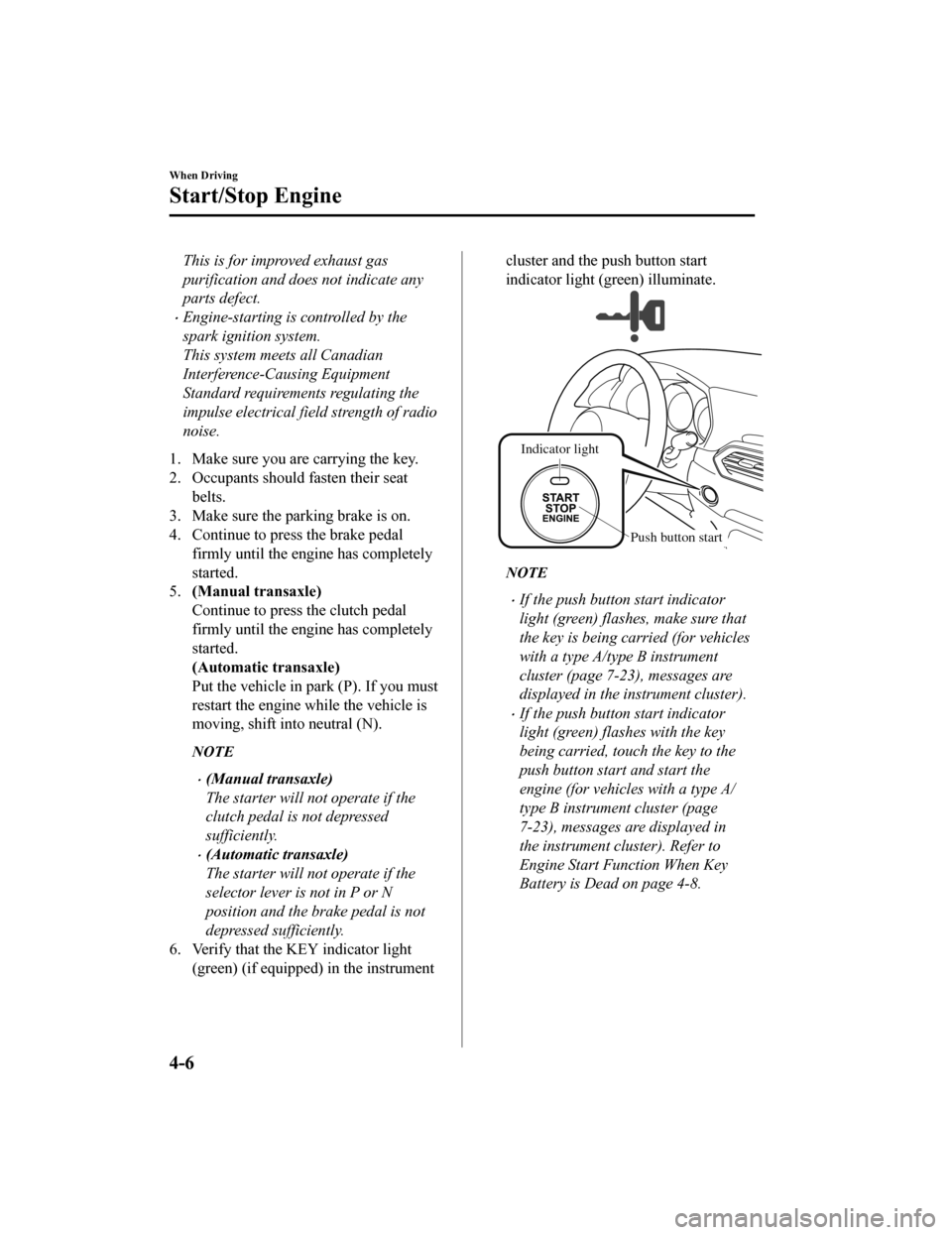
This is for improved exhaust gas
purification and does not indicate any
parts defect.
Engine-starting is controlled by the
spark ignition system.
This system meets all Canadian
Interference-Causing Equipment
Standard requirements regulating the
impulse electrical field strength of radio
noise.
1. Make sure you are carrying the key.
2. Occupants should fasten their seat belts.
3. Make sure the parking brake is on.
4. Continue to press the brake pedal firmly until the engine has completely
started.
5. (Manual transaxle)
Continue to press the clutch pedal
firmly until the engine has completely
started.
(Automatic transaxle)
Put the vehicle in park (P). If you must
restart the engine while the vehicle is
moving, shift into neutral (N).
NOTE
(Manual transaxle)
The starter will not operate if the
clutch pedal is not depressed
sufficiently.
(Automatic transaxle)
The starter will not operate if the
selector lever is not in P or N
position and the brake pedal is not
depressed sufficiently.
6. Verify that the KEY indicator light
(green) (if equipped) in the instrument
cluster and the push button start
indicator light (green) illuminate.
Indicator light
Push button start
NOTE
If the push button start indicator
light (green) flashes, make sure that
the key is being carried (for vehicles
with a type A/type B instrument
cluster (page 7-23), messages are
displayed in the instrument cluster).
If the push button start indicator
light (green) flashes with the key
being carried, touch the key to the
push button start and start the
engine (for vehicles with a type A/
type B instrument cluster (page
7-23), messages are displayed in
the instrument cluster). Refer to
Engine Start Function When Key
Battery is Dead on page 4-8.
When Driving
Start/Stop Engine
4-6
CX-5_8HX6-EA-19I_Edition2_old 2019-9-19 9:26:07
Page 515 of 714
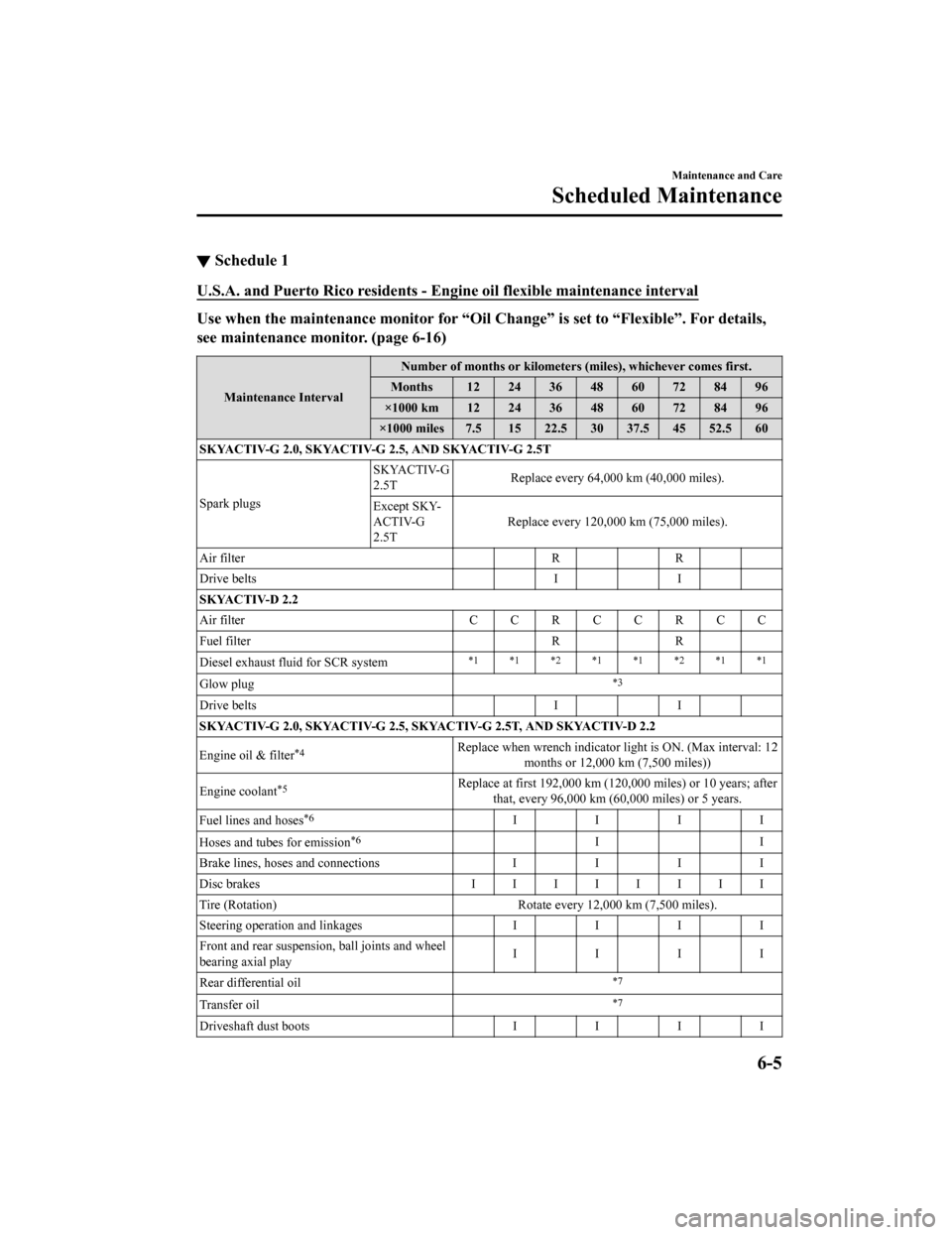
▼Schedule 1
U.S.A. and Puerto Rico residents - En
gine oil flexible maintenance interval
Use when the maintenance monitor for “Oil Change” is set to “Flexible”. For details,
see maintenance monitor. (page 6-16)
Maintenance Interval Number of months or kilometers (miles), whichever comes first.
Months 12 24 36 48 60 72 84 96
×1000 km 12 24 36 48 60 72 84 96
×1000 miles 7.5 15 22.5 30 37.5 45 52.5 60
SKYACTIV-G 2.0, SKYACTIV-G 2.5, AND SKYACTIV-G 2.5T
Spark plugs SKYACTIV-G
2.5T
Replace every 64,000 km (40,000 miles).
Except SKY-
ACTIV-G
2.5T Replace every 120,000 km
(75,000 miles).
Air filter RR
Drive belts II
SKYACTIV-D 2.2
Air filter CCRCCRCC
Fuel filter RR
Diesel exhaust fluid for SCR system
*1 *1 *2 *1 *1 *2 *1 *1
Glow plug*3
Drive belts II
SKYACTIV-G 2.0, SKYACTIV-G 2.5, SKYACTIV-G 2.5T, AND SKYACTIV-D 2.2
Engine oil & filter
*4Replace when wrench indicator light is ON. (Max interval: 12 months or 12,000 km (7,500 miles))
Engine coolant
*5Replace at first 192,000 km (120,0 00 miles) or 10 years; after
that, every 96,000 km (60,000 miles) or 5 years.
Fuel lines and hoses
*6IIII
Hoses and tubes for emission
*6II
Brake lines, hoses and connections I I I I
Disc brakes IIIIIIII
Tire (Rotation) Rotate every 12,000 km (7,500 miles).
Steering operation and linkages II II
Front and rear suspensi on, ball joints and wheel
bearing axial play IIII
Rear differential oil
*7
Transfer oil*7
Driveshaft dust boots II II
Maintenance and Care
Scheduled Maintenance
6-5
CX-5_8HX6-EA-19I_Edition2_old 2019-9-19 9:26:07
Page 517 of 714
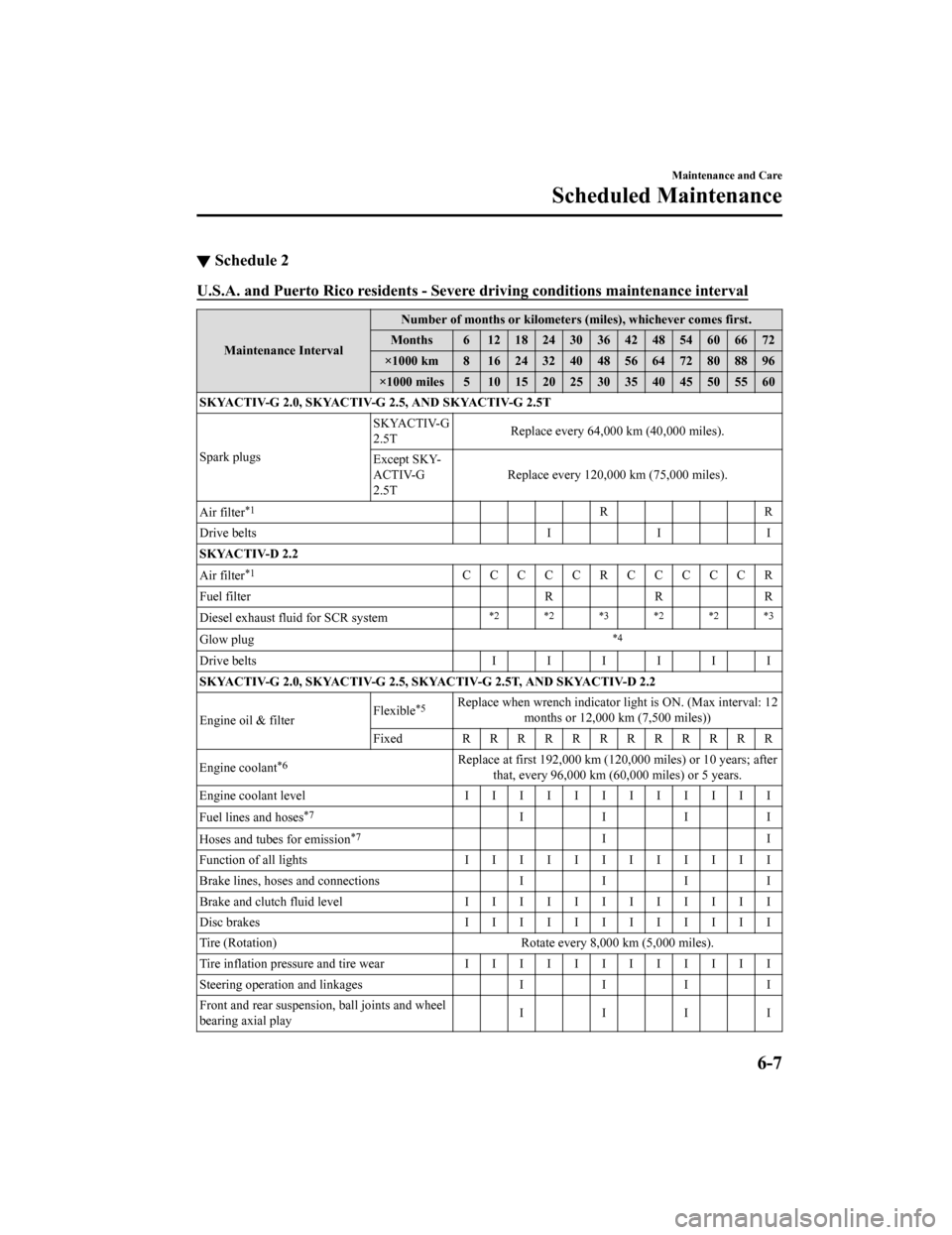
▼Schedule 2
U.S.A. and Puerto Rico residents - Severe
driving conditions maintenance interval
Maintenance Interval Number of months or kilometers (miles), whichever comes first.
Months 6 1218243036424854606672
×1000 km 8 1624324048566472808896
×1000 miles 5 10 15 20 25 30 35 40 45 50 55 60
SKYACTIV-G 2.0, SKYACTIV-G 2.5, AND SKYACTIV-G 2.5T
Spark plugs SKYACTIV-G
2.5T
Replace every 64,000 km (40,000 miles).
Except SKY-
ACTIV-G
2.5T Replace every 120,000 km
(75,000 miles).
Air filter
*1RR
Drive belts I I I
SKYACTIV-D 2.2
Air filter
*1CCCCCRCCCCCR
Fuel filter R R R
Diesel exhaust fluid for SCR system
*2 *2 *3 *2 *2 *3
Glow plug*4
Drive belts IIIIII
SKYACTIV-G 2.0, SKYACTIV-G 2.5, SKYACTIV-G 2.5T, AND SKYACTIV-D 2.2
Engine oil & filter Flexible
*5Replace when wrench indicator light is ON. (Max interval: 12
months or 12,000 km (7,500 miles))
Fixed RRRRRRRRRRRR
Engine coolant
*6Replace at first 192,000 km (120,0 00 miles) or 10 years; after
that, every 96,000 km (60,000 miles) or 5 years.
Engine coolant level IIIIIIIIIIII
Fuel lines and hoses
*7IIII
Hoses and tubes for emission
*7II
Function of all lights I I I I I I I I I I I I
Brake lines, hoses and connections III I
Brake and clutch fluid level I I I I I I I I I I I I
Disc brakes IIIIIIIIIIII
Tire (Rotation) Rotate every 8,000 km (5,000 miles).
Tire inflation pressure and tire wear IIIIIIIIIIII
Steering operation and linkages III I
Front and rear suspensi on, ball joints and wheel
bearing axial play IIII
Maintenance and Care
Scheduled Maintenance
6-7
CX-5_8HX6-EA-19I_Edition2_old
2019-9-19 9:26:07
Page 519 of 714
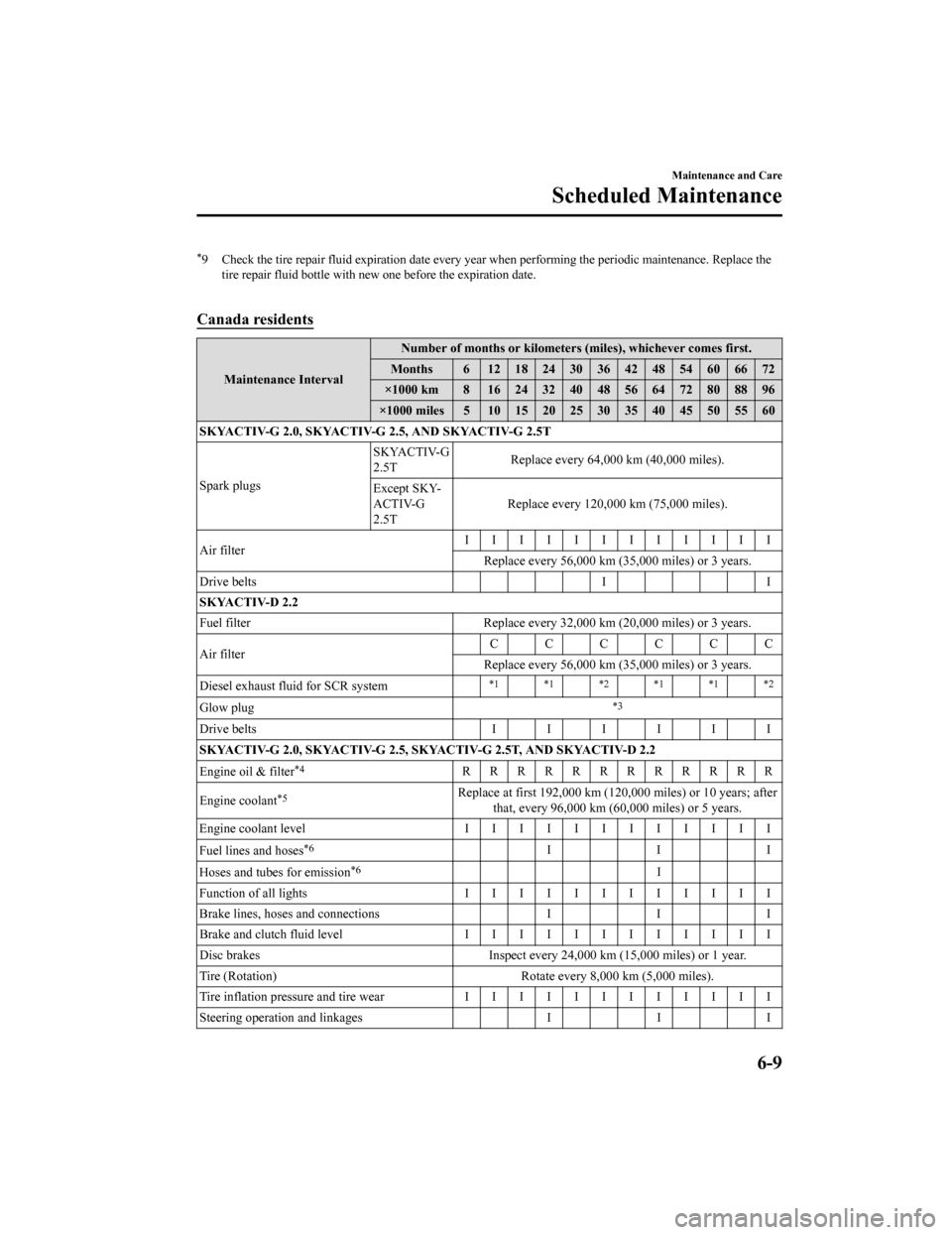
*9 Check the tire repair fluid expiration date every year when performing the periodic maintenance. Replace thetire repair fluid bottle with new one before the expiration date.
Canada residents
Maintenance Interval Number of months or kilometers (miles), whichever comes first.
Months 6 1218243036424854606672
×1000 km 8 1624324048566472808896
×1000 miles 5 10 15 20 25 30 35 40 45 50 55 60
SKYACTIV-G 2.0, SKYACTIV-G 2.5, AND SKYACTIV-G 2.5T
Spark plugs SKYACTIV-G
2.5T
Replace every 64,000 km (40,000 miles).
Except SKY-
ACTIV-G
2.5T Replace every 120,000 km
(75,000 miles).
Air filter IIIIIIIIIIII
Replace every 56,000 km (35,000 miles) or 3 years.
Drive belts I I
SKYACTIV-D 2.2
Fuel filter Replace every 32,000 km (20,000 miles) or 3 years.
Air filter CCCCCC
Replace every 56,000 km (35,000 miles) or 3 years.
Diesel exhaust fluid for SCR system
*1 *1 *2 *1 *1 *2
Glow plug*3
Drive belts IIIIII
SKYACTIV-G 2.0, SKYACTIV-G 2.5, SKYACTIV-G 2.5T, AND SKYACTIV-D 2.2
Engine oil & filter
*4RRRRRRRRRRRR
Engine coolant
*5Replace at first 192,000 km (120,0 00 miles) or 10 years; after
that, every 96,000 km (60,000 miles) or 5 years.
Engine coolant level IIIIIIIIIIII
Fuel lines and hoses
*6III
Hoses and tubes for emission
*6I
Function of all lights I I I I I I I I I I I I
Brake lines, hoses and connections III
Brake and clutch fluid level I I I I I I I I I I I I
Disc brakes Inspect every 24,000 km (15,000 miles) or 1 year.
Tire (Rotation) Rotate every 8,000 km (5,000 miles).
Tire inflation pressure and tire wear IIIIIIIIIIII
Steering operation and linkages III
Maintenance and Care
Scheduled Maintenance
6-9
CX-5_8HX6-EA-19I_Edition2_old 2019-9-19 9:26:07
Page 521 of 714
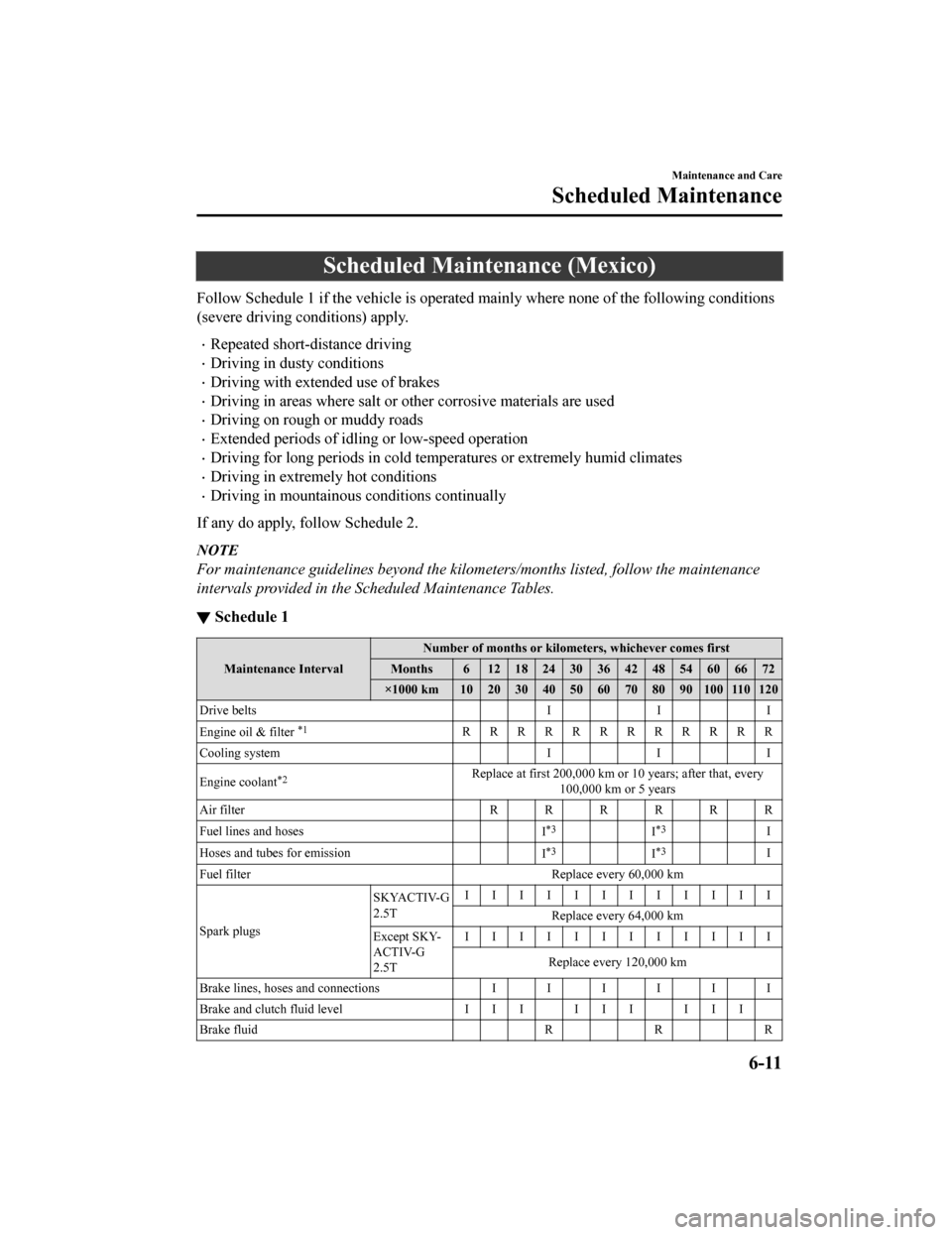
Scheduled Maintenance (Mexico)
Follow Schedule 1 if the vehicle is operated mainly where none of the following conditions
(severe driving conditions) apply.
Repeated short-distance driving
Driving in dusty conditions
Driving with extended use of brakes
Driving in areas where salt or other corrosive materials are used
Driving on rough or muddy roads
Extended periods of idling or low-speed operation
Driving for long periods in cold temp eratures or extremely humid climates
Driving in extremely hot conditions
Driving in mountainous conditions continually
If any do apply, follow Schedule 2.
NOTE
For maintenance guidelines beyond the kilometers/months listed, follow the maintenance
intervals provided in the Scheduled Maintenance Tables.
▼ Schedule 1
Maintenance Interval Number of months or kilometers, whichever comes first
Months 6 1218243036424854606672
×1000 km 10 20 30 40 50 60 70 80 90 100 110 120
Drive belts II I
Engine oil & filter
*1RRRRRRRRRRRR
Cooling system I I I
Engine coolant
*2Replace at first 200,000 km or 10 years; after that, every 100,000 km or 5 years
Air filter RRRRRR
Fuel lines and hoses I
*3I*3I
Hoses and tubes for emission I
*3I*3I
Fuel filter Replace every 60,000 km
Spark plugs SKYACTIV-G
2.5T
IIIIIIIIIIII
Replace every 64,000 km
Except SKY-
ACTIV-G
2.5T IIIIIIIIIIII
Replace every 120,000 km
Brake lines, hoses and connections IIIIII
Brake and clutch fluid level I I I I I I I I I
Brake fluid RRR
Maintenance and Care
Scheduled Maintenance
6-11
CX-5_8HX6-EA-19I_Edition2_old 2019-9-19 9:26:07
Page 523 of 714
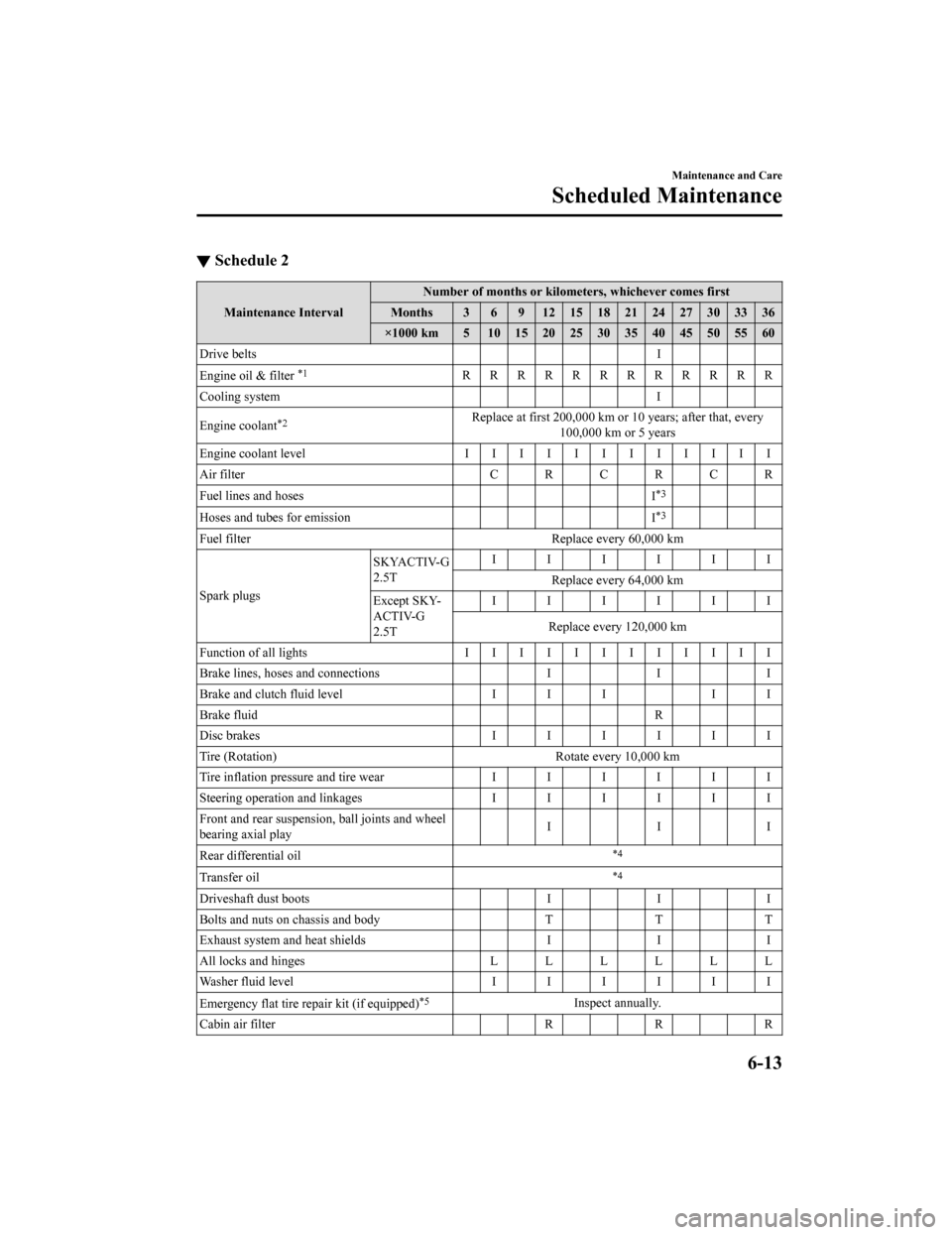
▼Schedule 2
Maintenance Interval Number of months or kilometers, whichever comes first
Months 3 6 9 121518212427303336
×1000 km 5 1015202530354045505560
Drive belts I
Engine oil & filter
*1RRRRRRRRRRRR
Cooling system I
Engine coolant
*2Replace at first 200,000 km or 10 years; after that, every 100,000 km or 5 years
Engine coolant level IIIIIIIIIIII
Air filter CRCRCR
Fuel lines and hoses I
*3
Hoses and tubes for emissionI*3
Fuel filterReplace every 60,000 km
Spark plugs SKYACTIV-G
2.5T
IIIIII
Replace every 64,000 km
Except SKY-
ACTIV-G
2.5T IIIIII
Replace every 120,000 km
Function of all lights I I I I I I I I I I I I
Brake lines, hoses and connections III
Brake and clutch fluid level I I II I
Brake fluid R
Disc brakes IIIIII
Tire (Rotation) Rotate every 10,000 km
Tire inflation pressure and tire wear IIIIII
Steering operation and linkages IIIIII
Front and rear suspensi on, ball joints and wheel
bearing axial play III
Rear differential oil
*4
Transfer oil*4
Driveshaft dust boots III
Bolts and nuts on chassis and body TT T
Exhaust system and heat shields III
All locks and hinges LLLLLL
Washer fluid level IIIIII
Emergency flat tire repair kit (if equipped)
*5Inspect annually.
Cabin air filter R R R
Maintenance and Care
Scheduled Maintenance
6-13
CX-5_8HX6-EA-19I_Edition2_old 2019-9-19 9:26:07
Page 524 of 714
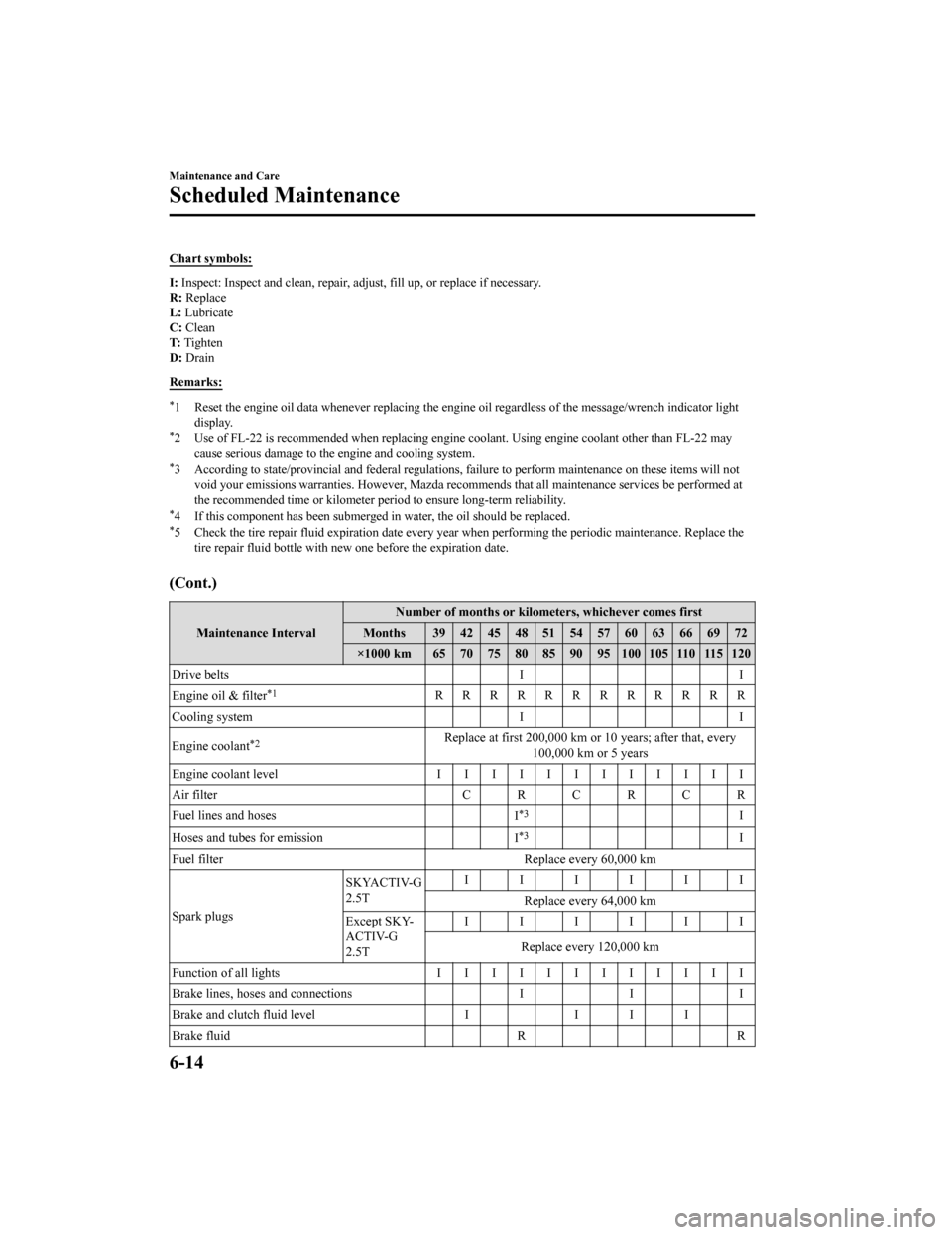
Chart symbols:
I: Inspect: Inspect and clean, repair, ad just, fill up, or replace if necessary.
R: Replace
L: Lubricate
C: Clean
T: Tighten
D: Drain
Remarks:
*1 Reset the engine oil data whenever replacing the engi ne oil regardless of the message/wrench indicator light
display.
*2 Use of FL-22 is recommended when replacing engine coolant. Using engine coolant other than FL-22 may
cause serious damage to the engine and cooling system.
*3 According to state/provincial and fede ral regulations, failure to perform maintenance on these items will not
void your emissions warranties. However, Mazda recomme nds that all maintenance services be performed at
the recommended time or kilometer period to ensure long-term reliability.
*4 If this component has been submerged in water, the oil should be replaced.*5 Check the tire repair fluid expiration date every year when performing the periodic maintenance. Replace the
tire repair fluid bottle with new one before the expiration date.
(Cont.)
Maintenance Interval Number of months or kilometers, whichever comes first
Months 39 42 45 48 51 54 57 60 63 66 69 72
×1000 km 65 70 75 80 85 90 95 100 105 110 115 120
Drive belts II
Engine oil & filter
*1RRRRRRRRRRRR
Cooling system I I
Engine coolant
*2Replace at first 200,000 km or 10 years; after that, every 100,000 km or 5 years
Engine coolant level IIIIIIIIIIII
Air filter CRCRCR
Fuel lines and hoses I
*3I
Hoses and tubes for emission I
*3I
Fuel filter Replace every 60,000 km
Spark plugs SKYACTIV-G
2.5T
IIIIII
Replace every 64,000 km
Except SKY-
ACTIV-G
2.5T IIIIII
Replace every 120,000 km
Function of all lights IIIIIIIIIIII
Brake lines, hoses and connections I I I
Brake and clutch fluid level I I I I
Brake fluid RR
Maintenance and Care
Scheduled Maintenance
6-14
CX-5_8HX6-EA-19I_Edition2_old 2019-9-19 9:26:07
Page 552 of 714

Battery
WA R N I N G
Wash hands after handling the battery and related accessories:
Battery posts, terminals and related accessories contain lead and lead compounds, chemicals
known to the State of California to cause cancer and reproductive harm.
Read the following precautions carefully before using the battery or inspecting to
ensure safe and correct handling:
Always wear eye protection when working near the battery:
Working without eye protection is dangerous. Battery fluid contains SULFURIC ACID which
could cause blindness if splashed into your ey es. Also, hydrogen gas produced during normal
battery operation, could ignite and cause the battery to explode.
Wear eye protection and protective gloves to prevent contact with battery fluid:
Spilled battery fluid is dangerous.
Battery fluid contains SULFURIC ACID which could ca use serious injuries if it gets in eyes, or on
the skin or clothing. If this happens, immediat ely flush your eyes with water for 15 minutes or
wash your skin thoroughly and get medical attention.
Always keep batteries out of the reach of children:
Allowing children to play near batteries is da ngerous. Battery fluid could cause serious injuries
if it gets in the eyes or on the skin.
Keep flames and sparks away from open battery cells and do not allow metal tools to
contact the positive (
) or negative () terminal of the battery when working near a battery.
Do not allow the positive (
) terminal to contact the vehicle body:
Flames and sparks near open battery cells a re dangerous. Hydrogen gas, produced during
normal battery operation, could ignite and cause the battery to explode. An exploding battery
can cause serious burns and injuries. Keep all flames including cigarettes and sparks away
from open battery cells.
Maintenance and Care
Owner Maintenance
6-42
CX-5_8HX6-EA-19I_Edition2_old 2019-9-19 9:26:07